Robert E. Howard Wrote a Police Procedural? With Conan?? Crom!!!
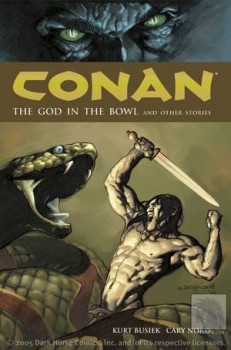 Reportedly, Ernest Hemingway bet Howard Hawks that the director couldn’t make a good movie out of his worst book. Hawks took the bet and we ended up with Humphrey Bogart in To Have and Have Not (it’s not Bogie’s best, but I vote Hawks the winner of the bet). Suppose I told you I could show you that one of what’s commonly considered among the worst Conan stories isn’t really that bad – and that it’s a pre-genre police procedural? Ready to take on the challenge?
Reportedly, Ernest Hemingway bet Howard Hawks that the director couldn’t make a good movie out of his worst book. Hawks took the bet and we ended up with Humphrey Bogart in To Have and Have Not (it’s not Bogie’s best, but I vote Hawks the winner of the bet). Suppose I told you I could show you that one of what’s commonly considered among the worst Conan stories isn’t really that bad – and that it’s a pre-genre police procedural? Ready to take on the challenge?
In 2015, Black Gate‘s Discovering Robert E. Howard series showcased the breadth and diversity of REH’s writings. Boxing stories, westerns, science fiction, Solomon Kane, El Borak: Howard was an immensely talented author who wrote in a variety of genres. My first entry in the series was about Steve Harrison, Howard’s take on the hardboiled private eye with a weird menace twist. As you can read in that essay, Howard didn’t care for the genre and he abandoned it almost as quickly as he entered it. Today, I’m going to look at his lone police procedural. Yep – Robert E. Howard wrote a police procedural before the term was even in use. And it features Conan!
The general consensus is that Howard hit the mark with his fourth Conan story, “The Tower of the Elephant,” published in March of 1933. His first was “The Phoenix on the Sword,” which appeared in Weird Tales in December of 1932 and was a rewrite of an unpublished Kull story, “By This Axe I Rule.” Farnsworth Wright, editor of Weird Tales, rejected the second, “The Frost Giant’s Daughter,” which to me, reads more like a chapter in a longer work than a self-contained story.
“The God in the Bowl” was probably written in early 1932 and was Howard’s third Conan story. Wright rejected this one as well and it did not see print in any form until an edited version by L. Sprague de Camp was published in 1952’s Space Science Fiction, Volume 1, Number 2 (the story has nothing to do with either space or science fiction…). De Camp did less chopping on this one than most of his Conan edits, but fans could finally read Howard’s original text in Donald Grant’s The Tower of the Elephant in 1975.
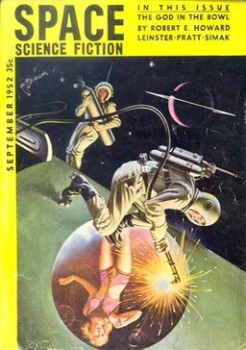 He next wrote his world-shaping essay, “The Hyborian Age,” which many feel gave him a framework that contributed to “The Tower of the Elephant” being such a fine story.
He next wrote his world-shaping essay, “The Hyborian Age,” which many feel gave him a framework that contributed to “The Tower of the Elephant” being such a fine story.
Okay – moving on from Conan for a bit…
Police Procedurals, eh?
It’s easy to track the beginning of the hard-boiled genre to Carroll John Daly and Dashiell Hammett in the pages of Black Mask Magazine in 1922 and 1923. The police procedural’s beginning is not quite so clearly delineated. You could argue for novels here and there, like 1868’s The Moonstone, by Wilkie Collins. Sergeant Cuff is a police detective, but I wouldn’t call this a procedural.
Georges Simenon’s Inspector Maigret (which you know is currently being adapted in a series of tv movies because you used to LOVE The Public Life of Sherlock Holmes column here at Black Gate…), who first appeared in 1931, is a policeman, but he essentially functions as an independent protagonist. There were novels here and there, such as Lawrence Treat’s V as in Victim and Hillary Waugh’s Last Seen Wearing, but these came after “The God in the Bowl.”
Police procedurals actually gained their footing due to radio shows such as Dragnet and films like The Street With No Name (a classic). Today, police procedurals are far more commonly linked to television shows than books.
Ed McBain (Evan Hunter) began his popular 87th Precinct series in 1956 and that’s as good a point as any to identify as the establishment of the police procedural in fiction. A few years later, Per Wahloo and Maj Sjowall created Danish police detective Martin Beck, which further entrenched the genre. Tony Hillerman, who I wrote about here, wrote procedurals featuring the Navajo Tribal Police.
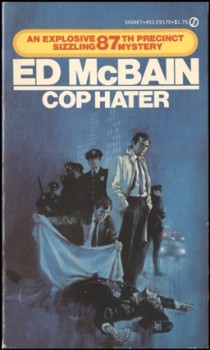 But in 1932, Robert E. Howard was, once again, ahead of his time.
But in 1932, Robert E. Howard was, once again, ahead of his time.
The police procedural differs from the detective-driven mystery, whether that private investigator is Sherlock Holmes or Sam Spade. In the classical and hard-boiled schools of mystery fiction, the detective worked outside of the authorities, usually holding back information from the police.
We’re used to seeing the private eye/police officer dichotomy: Sherlock Holmes/Inspector Lestrade, Sam Spade/Lt. Dundee, Adrian Monk/Captain Stottleymer, Hercule Poirot/Inspector Japp, et al. The detective solves the crime while the police follow along, never able to work things out themselves. In the police procedural, it’s the cops that go through the step-by-step process of breaking a case.
In a procedural, the detective is a member of the force and they must follow the rules and regulations required of them. Though, of course, those can vary by time and locale. In one of the early Nero Wolfe books (I know, not a police procedural!), Archie watches someone he turned in to the police get worked over in the basement by a cop. That was the norm of the time, though Rex Stout was less obvious about it in future stories.
The policeman doesn’t solve the crime by knowing what kind of mud can only be found in a certain part of town, and he generally doesn’t make some brilliant deduction that a ‘normal’ investigator couldn’t. Crime scenes are examined, questions are asked and set routines are followed. I think of it as ‘grunt work.’ It’s not called a procedural for nothing!
The stories aren’t just about the policemen and the processes they go through to solve a crime, but they’re about the world they work in, from the station house to the streets they protect. In that way, the genre does resemble the hard-boiled school, which was as much about the mean streets the detectives strode down as about the detectives themselves. We certainly get a look at what justice was like in Conan’s Nemedia.
So, can we look at “The God in the Bowl,” a Conan story, and see the elements of a police procedural? Yes, we can. And with a weird menace element, of course. We’re talking about Robert E. Howard here.
A Night at the Museum
SPOILER ALERT: We’re about to discuss a 17-page story. If you want to go read it, it won’t take you long. The nature of this post is that it is essentially a spoiler, so you’re on your own as far as responsibility goes. Here’s the opening:
Arus the watchman grasped his crossbow with shaky hands, and he felt beads of clammy perspiration on his skin as he stared at the unlovely corpse sprawling on the polished floor before him. It is not pleasant to come upon Death in a lonely place at midnight.
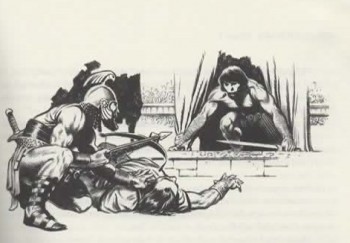 Man! I read a LOT, and nobody writes like REH did. Arus is the night guard at Kallian Publico’s Temple (museum), in the Nemedian city of Numalia. Now, we all know how creepy museums seem at night. Here we’ve got a hired sword unexpectedly coming across an “unlovely corpse.” And not just any body, this is Kallian himself!
Man! I read a LOT, and nobody writes like REH did. Arus is the night guard at Kallian Publico’s Temple (museum), in the Nemedian city of Numalia. Now, we all know how creepy museums seem at night. Here we’ve got a hired sword unexpectedly coming across an “unlovely corpse.” And not just any body, this is Kallian himself!
From the description, it appears that Kallian had been poisoned or strangled. Before Arus can get his mental footing, a huge, nearly naked, young Conan comes out of an adjoining room. Arus, likely all but peeing in his pants at the sight of this huge savage, accuses Conan of killing Kallian and pulls the hanging rope that sounds an alarm outside.
The Official Force Takes Over
Almost immediately, five men of the city watch, armed to the teeth, enter the room, led by a sixth. This last is Demetrio, Chief of the Inquisitorial Council. The watch defers to him, including their leader, Dionus, the Prefect of Police. For all intents and purposes, Demetrio is a member of the watch for this story.
There are three policemen of note in this story: Demetrio, Dionus and another watchman named Posthumo. All the others are merely armed fodder. Think of them as red-shirted security officers from Star Trek.
Dionus immediately establishes himself as a stereotypical bully. When asked if he killed Kallian, Conan shakes his head but refuses to answer aloud. When berated by Demetrio, Conan replies that he is no dog. Dionus exclaims, “
“Oh, an insolent fellow! An independent cur! One of those citizens with rights, eh? I’ll soon knock it out of him! Here, you! Come clean!”
We already know what kind of policeman he is.
Demetrio steps in and takes charge of the questioning. He asks several relevant questions of the museum guard, Arus. Dionus breaks in, showing his true colors again.
Why go to all the trouble of questions and speculations. It’s much easier to beat a confession out of a suspect. Here’s our man, no doubt about it. Let’s take him to the Court of Justice. I’ll get a statement if I have to mash his bones to a pulp.
Conan is not intimidated by the official force. When Demetrio asks what he has to say, Conan replies,
“That any man who touches me will quickly be greeting his ancestors in hell.”
When Demetrio begins to threaten Conan, he is cut off abruptly by the Cimmerian.
“Save your bullying for the fools who fear you. I’m no city-bred Nemedian to cringe before your hired dogs. I’ve killed better men than you for less than this.”
We have clearly established three characters: the good cop, the bad cop and the thief. Dionus reminds me of Lieutenant Com Noonan of the State Police in the Nero Wolfe story, “Door to Death.” His primary conversational contribution is to let Wolfe and Archie know that if it were up to him he would take them to the state barracks as material witnesses and presumably work them over.
Dionus is a one-dimensional heavy who serves to show how little justice the common person could expect to receive from the police of Numalia. He is a loudmouthed bully and he has that role only in the story.
As we’ll see, Demetrio is actually a competent policeman. He asks relevant questions, reconstructs events and leads the investigation. Up to a point, it’s reasonable to think of him as the story’s protagonist.
There’s one other watch member we’ll encounter, Posthumo. He is merely a rank and file version of Dionus, contributing nothing beyond bullying a helpless citizen. Dionus could have served the role just as well. I’m not sure why Howard included Posthumo, other than to show that the men serving under Dionus are no better than he is.
You Don’t Bully a Cimmerian
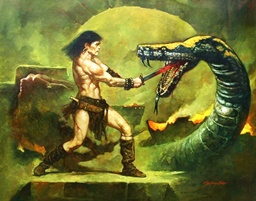 Conan is, of course, the thief. He played that role in this story and the next,”The Tower of the Elephant.” Dionus is convinced he is the murderer. Demetrio, who is willing to look at the facts and then come to a conclusion, isn’t so sure. Demetrio is Holmes to Dionus’ Lestrade (that’s actually a bit unfair to Lestrade, but you get the point).
Conan is, of course, the thief. He played that role in this story and the next,”The Tower of the Elephant.” Dionus is convinced he is the murderer. Demetrio, who is willing to look at the facts and then come to a conclusion, isn’t so sure. Demetrio is Holmes to Dionus’ Lestrade (that’s actually a bit unfair to Lestrade, but you get the point).
Back to the story: The situation is tense. The rank and file police expect Demetrio to order them to seize the barbarian. I imagine they aren’t too keen on the prospect. But the Inquisitor knows that there will be much bloodshed if they try to take Conan by force. It might even go the wrong way. Also, he still has doubts that Conan is guilty. He is clearly a much better cop than Dionus. He continues the discussion, getting Conan to recount his movements.
When Arus makes a clueless statement about Cimmerians, Demetrio dismisses him out of hand. Demetrio continues the interrogation, coaxing Conan into admitting that he had come to steal something from the museum. H’s doing a pretty good job of investigating.
Dionus, always consistent, jumps in again.
“And to kill Kallian Publico. By Mitra, we’ve hit it. Grab him, men! We’ll have a confession before morning!”
Dionus has a role to play, but he certainly is a carboard cutout.
Conan whips out his sword and it’s clear he is not intimidated.
Back if you value your dog lives!,” he snarled, his blue eyes blazing. “Because you dare to torture shop-keepers and strip and beat harlots to make them talk, don’t think you can lay your fat paws on a Hillman! I’ll take some of you to hell with me. Fumble with your bow, watchman – I’ll burst your guts with my heel before the night’s work is over!
Conan was raised in the bleak northlands of Cimmeria. He may be a thief, but he is also a scarred warrior who will bow before no man. Dionus (and Posthumo, who we’ve not actually met yet) are completely ineffectual versus him. What we have is a contest between Demetrio and Conan. That is at the heart of this story.
Demetrio wants to solve a murder and he has corralled a thief (you can’t exactly call Conan ‘captured’ at the moment); there may be two totally unrelated crimes here.
The Inquisitor orders Dionus to call off his men, telling the prefect he’s not convinced Conan is the murderer. He also whispers, “You fool, wait until we can summon more men, or trick him into laying down his sword.” Demetrio wants to keep things on an intellectual plain, not a physical one. As we’ll see, that’s a savvy approach.
Policeman at Work
After failing to get Conan to lay down his sword, Demetrio wonders why the barbarian would strangle Publius, instead of using his sword.
Dionus contributes nothing useful as usual, muttering, “Perhaps to divert suspicion.”
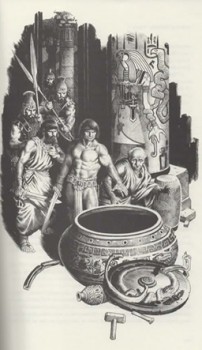 Again, we’re reminded of the smart private eye and the less intelligent police officer. Except here it’s the smart cop and the dumb cop. Demetrio continues gathering evidence to weigh against Conan’s story and tries to figure out the likely course of events which transpired.
Again, we’re reminded of the smart private eye and the less intelligent police officer. Except here it’s the smart cop and the dumb cop. Demetrio continues gathering evidence to weigh against Conan’s story and tries to figure out the likely course of events which transpired.
Demetrio then feels the body to determine the time of death and analyzes Conan’s timetable, establishing that either the man is innocent or lying.
Demetrio is clearly the only actual detective in the story, even though he isn’t in fact a policeman. After speculating on the possible murder weapon, he recreates Kallian’s movements during the attack on the dead man. Throughout the story, he is the only one to impress the reader with his intelligence and acumen.
Dionus is growing boring to the reader, tossing in, “And if the heathen isn’t the murderer, where is he?” You can almost tune him out.
Demetrio hears a chariot stopping nearby and orders the guards to bring the driver, as well as Kallian’s chief clerk, who lives nearby. Enaro, Publico’s charioteer, is a powerfully built dark-skinned man and a debtor slave. He shows no remorse at his master’s demise.
Promero, “a small, timid looking” man, is a spineless clerk and cries out, “Oh, I knew evil would come of this,” when he sees Kallian’s body. Why not just yell out, ‘Please beat me brutally until I tell you what I know.’?
Enaro accounts for his whereabouts, while Promero is obviously lying. Demetrio lets Dionus loose on the clerk and the Prefect signals to Posthumo, one of his men. Enaro comments that Posthumo gouged out a girl’s eye in the Court of Justice because she wouldn’t give information incriminating her lover. (Blue’s clue — Foreshadowing!)
Posthumo makes Dionus look like an intellectual.
“I always get what I go after!” bellowed the guardsman, the veins in his thick neck swelling, and his face growing purple….”Speak up, you rat!”
Oh man: that’s not good writing.
He then slaps Promero “terrifically” on one side of his face, then the other, after which he tosses him to the floor and kicks him. The broken clerk begs him to stop, offering to tell all that he knows.
“Then get up, you cur,” roared Posthumo, swelling with self-importance.
Of course, Dionus has to show his colors again. He glances at Conan. “You see what happens to those who cross the police?”
The barbarian is as impressed as one would expect.
The Cimmerian spat with a sneer of cruel contempt for the moaning clerk. “He’s a weakling and a fool,” he growled. “Let one of you touch me and I’ll spill his guts on the floor.
Early Conan was a bit less eloquent than he would later be.
“Are you ready to talk?” asked Demetrio tiredly. He found these scenes wearingly monotonous.
The Talking Head
I think a major weakness in the story is that Promero gives a long exposition in which we learn that an ancient, round sarcophagus had arrived from Stygia, to be delivered to Kalanthes, a priest of Ibis. Of course, Ibis is an enemy of Set, so something seems odd.
Kallian was determined to open the sarcophagus and steal whatever treasure was inside. He would hide the treasure, then ‘discover’ the theft the following morning, having the Arus the guard crucified after accusing him of being the inside man for the theft.
It definitely moves the story forward, in that we know why Kallian was there after hours and gives us an actual object to focus the investigation on. But the police gain this information by doing nothing more than beating up a meek accountant. It is too easy. It may well have been a necessary device, but it doesn’t feel up to the standards of Howard.
Somebody Needs to be Arrested
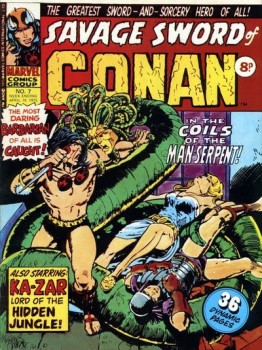 Dionus orders a search of the entire museum, as he believes that if Conan isn’t the murderer, the killer must still be on the premises. This is actually good police work and I’m surprised Demetrio hadn’t thought of it earlier. Of course, Dionus’ motivation is to hang the crime on Conan, but it doesn’t alter the fact that it was a logical and called-for step. Sadly, this is his lone moment of competence.
Dionus orders a search of the entire museum, as he believes that if Conan isn’t the murderer, the killer must still be on the premises. This is actually good police work and I’m surprised Demetrio hadn’t thought of it earlier. Of course, Dionus’ motivation is to hang the crime on Conan, but it doesn’t alter the fact that it was a logical and called-for step. Sadly, this is his lone moment of competence.
The Prefect also makes an interesting point about Nemedian justice: Killing a commoner results in one being sentenced to hard labor in the mines. Killing a tradesman is a hanging offense. And killing rich man like Kallian results in burning: presumably a public spectacle. Justice isn’t blind — she’s just winking one eye.
Conan admits that someone gave him a map of the museum and told him where to find a Zamorian diamond goblet, but he refuses to name his employer.
An unnamed policeman says he has found the murder weapon, a thick, black, splotched cable, in the next room. But it’s gone when they go in to see it and Demetrio dismisses the man’s claim. Friends have told me they figured it out at this point, but I didn’t. I probably should have, as Howard has ‘played fair’ and given us all the clues needed to solve Kallianâ’s killing. Guess I didn’t have my deerstalker on (I do have one, naturally).
Demetrio seems to be tiring of the whole evening and is ready to go home.
“No, I tell you, Conan didn’t commit the murder. I believe the real murderer killed Kallian to secure whatever was in the Bowl, and is hiding now in some secret nook in the Temple. If we can’t find him, we’ll have to put the blame on the barbarian, to satisfy Justice…”
Something happens and Demtrio’s comment is cut off. But I think that this is a really notable moment in the story and I’d like to see a real Howard scholar (as opposed to me) explore it. Demtrio has arguably been the protagonist thus far. He’s certainly the only admirable character from the law enforcement ensemble. Since Conan has just stood there, said he didn’t kill Kallian and has threatened to kill anybody that bothers him, he’s not exactly the story’s center.
But there is no way we can make Demetrio the hero of the story now. He’s certain that Conan didn’t commit the murder, but hey, somebody’s gotta hang. And if Demetrio can’t find who actually killed the museum owner, well, then, the foreigner caught in the wrong place at the wrong time will have to do. Demetrio isn’t a good(ish) guy anymore. He’s a corrupt policeman with almost absolute authority (standard villain hallmarks). And he’s going to railroad an innocent (well, of the crime at hand, anyways) man to execution. The whole story has pivoted at this moment.
There absolutely is an essay on justice, policemen and culture in this short speech from Demetrio that should be explored by somebody up to the task.
Okay — back to the scene.
Promero comes back into the room and reveals that the Bowl bears the mark of the Stygian sorcerer, Thoth-amon. The master of the dark arts had obviously sent some deadly horror to kill Kalenthes, his enemy, and Kallian had released it.
Howard shows a spark of humor here as Promero’s wild-eyed hysteria is cut short:
“You gibbering fool!” roared Dionus disgustedly, striking him heavily across the mouth. Dionus was a materialist, with scant patience for any speculations.
That’s some nice wit!
Dionus then tells Demetrio that the only option is to arrest Conan, who interrupts him and says that he saw a long dark shadow slithering across the floor of the Bowl room. Promero panics again and Posthumo tosses him into the other room where the shadow was seen.
Dionus seems to be ready to arrest Conan, who in turn is ready to spill some blood, when a guardsman enters, dragging a richly dressed man who turns out to be Aztrias Petanius, the city governor’s nephew. Aztrias explains he had been passing by after a night of revelry and Dionus tells him they have the man who is doubtless guilty.
A Little Perspective on this Story in the Conan Canon
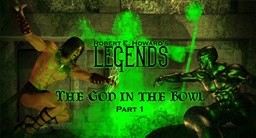 Quite a few of my REH friends and acquaintances don’t care for this story, including Black Gate Managing Editor, Howard Andrew Jones. As far as Conan stories go, it’s been rather dull on the action scale. A guard found the owner of a museum murdered. Conan had been there to steal something and when the police were summoned, he was the only suspect. Up to this point, there’s been a whole lot of standing around, talking. We haven’t even seen any blood spilled (the murdered man was strangled).
Quite a few of my REH friends and acquaintances don’t care for this story, including Black Gate Managing Editor, Howard Andrew Jones. As far as Conan stories go, it’s been rather dull on the action scale. A guard found the owner of a museum murdered. Conan had been there to steal something and when the police were summoned, he was the only suspect. Up to this point, there’s been a whole lot of standing around, talking. We haven’t even seen any blood spilled (the murdered man was strangled).
I’m not saying looking at “The God in the Bowl” as a pre-genre police procedural makes it a Robert E. Howard classic. However, when putting it within the proper context, what you’ve got is a workmanlike procedural with a couple of interesting characters (Demetrio and Conan). And things are absolutely about to pick up. What Howard has done to this point is set up a blistering Conan action scene, leading to a supernatural Hyborian finale. Instead of being bored with a non-action Conan story so far, credit Howard for having managed to enmesh Conan in a police procedural which is about to shift gears into an action sword and sorcery tale.
And Things are about to get Busy!
“A vicious looking brute! How can any doubt his guilt? I have never seen such a villainous countenance before.”
And now we have a very angry barbarian on our hands. A standard trope in the crime caper is having the thieves fall out. Conan reveals that it was Aztrias who hired him to steal the goblet and who had been waiting outside to receive it from Conan. He demands that Aztrias vouch for his entry into the museum, eliminating him as a murder suspect.
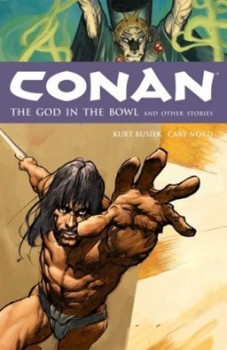 Demetrio, a practical man, tells Aztrias that if Conan’s assertions are true, the attempted theft can be hushed up and while Conan is due ten years of hard labor for house-breaking, an escape can be arranged. Everything will be kept quiet for the governor’s nephew.
Demetrio, a practical man, tells Aztrias that if Conan’s assertions are true, the attempted theft can be hushed up and while Conan is due ten years of hard labor for house-breaking, an escape can be arranged. Everything will be kept quiet for the governor’s nephew.
A man’s life can rest on one crucial decision. Aztrias has two very clear choices. He went with,
“I know him not. He is mad to say I hired him. Let him take his just desserts. He has a strong back and the toil in the mines will be well for him.”
He’d probably like to have that one back, though he doesn’t have long to rue his decision.
Conan drops his head, seemingly resigned to his fate. Keep in mind, there has been zero action in the story so far. I mean, none. But now, we get the Robert E. Howard we normally associate with Conan (again: this was just his third try at writing the character):
He struck with no more warning than a striking cobra; his sword flashed in the candle light. Aztrias shrieked and his head flew from his shoulders in a shower of blood, the features frozen in a white mask of horror. Catlike Conan wheeled and thrust murderously for Demetrio’s groin. The Inquisitor’s instinctive recoil barely deflected the point which sank into his thigh, glanced from the bone and ploughed out through the outer side of the leg. Demetrio went to his knee with a groan, unnerved and nauseated with agony.
WOW! I’ve said many times before that I think Robert E. Howard remains the best fantasy writer I’ve read yet. This story just absolutely exploded! In the next paragraph, Conan slices off one of Dionus’ ears and gouges out one of Posthumo’s eyes. After that, he nearly puts his sandaled foot through Arus’ stomach and then he kicks him in the mouth.
“The wretch screamed through a ruin of splintered teeth, blowing bloody froth from his mangled lips.”
I also like that Posthumo, who had gouged out a woman’s eye because she didn’t give him some information he wanted (likely he was demanding false testimony), has his own eye gouged out by Conan. That’s irony.
We are done with the police procedural: it’s over. Normally, at this stage (well, actually, before the sword attack), the police would arrest the culprit. We have moved into the realm of the sword and sorcery story now. Howard has given us a violent melee combat and now he will move us forward and solve the mystery. And to do so he’ll go deep into the history of Stygia, the Egyptian-like culture built on dark sorcery.
A terrifying scream comes from the next room and Promero, sobbing like an idiot, comes into the room. All action is arrested. Again, Howard knows how to put words together:
All halted to stare at him aghast — Conan with his dripping sword, the police with their lifted bills, Demetrio crouching on the floor and striving to staunch the blood that jetted from the great gash in his thigh, Dionus clutching the bleeding stump of his severed ear, Arus weeping and spitting out fragments of broken teeth – even Posthumo ceased his howls and blinked whimpering through the bloody mist that veiled his half-sight.
I mean, c’mon. That is some fantastic writing!
Time to Wrap Things Up
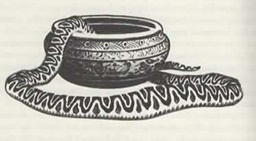 Promero babbles about a god with a long neck and dies. Horror sweeps over those in the room and they all flee, with the exception of Conan. Posthumo is knocked down and trampled by his colleagues, but crawls along after them. I find it a satisfying exit for the thuggish policeman. The group hurtles into the street, panicking the guards outside, who also flee.
Promero babbles about a god with a long neck and dies. Horror sweeps over those in the room and they all flee, with the exception of Conan. Posthumo is knocked down and trampled by his colleagues, but crawls along after them. I find it a satisfying exit for the thuggish policeman. The group hurtles into the street, panicking the guards outside, who also flee.
Conan, alone, strides into the next room and above a screen sees the inhumanly beautiful face of one of the god-men who ruled Stygia long ago. Conan leaps and slashes with his sword. The head topples to the side and the snake-body it had been attached to writhes and thrashes until it too dies. Conan has slain one of the ancient Children of Set (I think: the text is a little confusing to me). Even the hardy barbarian has seen too much and he flees from the city.
So: Ready to Call it a Police Procedural?
Just as Howard had written hard boiled private eye stories with a Sax Rohmer flavor via his Steve Harrison tales, he actually wrote a police procedural (before the term existed) with Conan. Demetrio seems to be a fairly honest cop, trying to solve the murder of a prominent citizen. While he is the most intelligent person in the story, his professional ethics are a bit lacking.
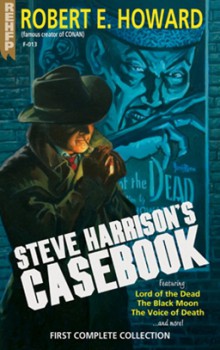
Dionus and Posthumo are the crooked bully cops who beat confessions out of suspects. Aztrias is the rich citizen largely above the law, though not beyond savage justice. Conan is the common thief abused by everyone of any stature. Arus is the private officer looked down upon by the official force.
Demetrio tries to work out what really happened using traditional methods. He doesn’t have flashes of insight or draw on exotic knowledge. Sadly, his inclination to cut corners with justice puts an innocent man on edge and the sudden outburst of violence is both breathtaking and unfortunate for just about every named character.
This is very much a closed-environment procedural: I think it could be turned into a play. All of the action takes place in a hallway and one adjacent room. Combined with the copious amounts of talking, this is likely a major reason why it seems like most Conan fans do not care for this story. It is quite different from every other one that Howard wrote.
But “The God in the Bowl” can be considered a very early police procedural, written over two decades before Ed McBain began to dominate the genre. As such, the story works better than merely as an early Conan tale. As I mentioned in my Steve Harrison article, Howard did not like the hard-boiled genre and abandoned it quickly. Likewise, I am not aware of any other story he wrote that could be classified as a police procedural. In fact, the very next Conan story was a crime caper!
As we highlighted here at Black Gate with our Discovering Robert E. Howard series, the man had an amazing breadth. With this look at “The God in the Bowl,” we can add one more category to his amazing diversity.
I’ll add that the atmospheric opening, the constant theme of the ‘civilized man’ bullying the ‘primitive savage,’ the character of Demetrio, the lore of ancient Hyboria and the inclusion of Thoth-Amon, the explosiveness of the action and the exotic finish: while this is not one of the best Conan stories, it isn’t as bad as commonly credited and I think it can stand up to its predecessor, “The Frost Giant’s Daughter.” Of course, both were rejected by Weird Tales and neither was published during Howard’s sadly shortened lifetime…
So — how’d I do on that challenge in the first paragraph?
Endale Media made sort-of-a live graphic comic version of the story, which you can watch here.
Other Robert E. Howard-related posts I’ve written here at Black Gate:
Robert E. Howard Goes Hard Boiled
Conan of Venarium by Harry Turtledove
The Tor Conan
Are Conan Pastiches Official?
The New Conan RPG
Bob Byrne’s ‘The Public Life of Sherlock Holmes’ column ran every Monday morning at Black Gate from March 10, 2014 through March 20, 2017. He also organized Black Gate’s award-nominated ‘Discovering Robert E. Howard’ series.
He is a member of the Praed Street Irregulars, founded www.SolarPons.com, the only website dedicated to the ‘Sherlock Holmes of Praed Street’ and blogs about Holmes and other mystery matters at Almost Holmes.
He has contributed stories to The MX Book of New Sherlock Holmes Stories – Parts III, IV and V and VI and will be in IX if he quits having fun writing Black Gate posts and works on a story!
i hate to b be picky, but the bet Hemingway made was with Howard Hawks.
Bill – Fixed. An error in the first sentence. Nothing like starting strong…
Calling it a police procedural sounds like a stretch. But I haven’t ready much (or any?) of that genre so I shouldn’t really comment on that.
I love this story. The ending brings it all together for me. The whole thing would have been ruined had Conan tried to stay and fight. Instead we see where his limits are.
Thats what made this one stick out to me the first time I read anything by REH.
I agree with you, Glenn. This one has always been a favorite of mine since I first read it in the Lancer paperback and then in Marvel’s adaptation. This is clearly an early visit to civilization and one that is essential before we can get to “Rogues in the House” where Conan is no longer a fish out of water, but has now mastered his environment. The writing is strong and atmospheric. The fact that it is rated low by many fans has always puzzled me. Of course, I don’t rate any REH Conan as disappointing. He did what no one else had done before with the fantasy genre. While the police procedural phrase may not have existed as a sub-genre of the mystery, there were examples in the 19th Century such as Paul Feval’s JEAN DIABLE. “There is nothing new under the sun.”
Good points. Demetrio probably was a bit more idealistic in his youth. He appears to have been in the military at some point where he saw Cimmerians in action. Very likely in the Border Kingdom. I look upon him as a a case study in how working within a corrupt bureaucracy gradually skews the moral compass even of just men. He TRIED to do the right thing, but ultimately it was just too much hassle.
Texan politics/bureaucracy during REH’s lifetime was quite corrupt. Read Frank Hamer’s bio or any honest book on LBJ’s early career. Howard was writing based on real life. He would comment on police brutality to Lovecraft. HPL’s disbelief is one of the things that led to their “civilization vs barbarism” debate.
Speaking of HPL, he quite liked this Conan yarn.
I wouldn’t say there is “no action” before Conan explodes. There is mounting brutality from the cops against OTHER people than Conan as the story goes on, increasing the tension. As a reader, I knew Conan wouldn’t go peacefully and the cops had it in for ‘im. A trainwreck was inevitable.
The scene with Aztrias is quite similar to one found in Harold Lamb’s Constantinople tale, “The Shield”.
The ending is what makes this tale. Cosmic horror is evoked with powerful subtlety. Conan realizes that men were not always ruled by men and that he was ALMOST meat for one of the eldritch Giant-Kings of Stygia without a blow ever being struck. Not hard to see why HPL liked this.
My main gripe with this is Thoth-Amon’s hamfisted assassination attempt. It doesn’t really make sense unless Karanthes is an utter dolt — and I sincerely doubt he is, since he’s survived this long fighting the Stygian Set cult. Thoth the Unabomber.
Deuce – Hey, I finally wrote it! I like the idea of Demetrio having been beaten down by the system over time.
There’s a Casting Crowns song called ‘Slow Fade’ in which a man gradually takes step after step down a path of moral decay. It doesn’t just happen in one big ‘boom.’ It’s a gradual process.
I think Demetrio is one of the most interesting supporting characters in the Conan Canon.
Bob Byrne and REH–going for that first spot again for the month!
I’m reading the Del Rey ‘Sword Woman’ as fast as I can so I can cobble together a post for September….Errr…rather, I mean, I’m digging deep into Howard’s fascinating collection of historical adventures, hoping to write a post worthy of these fine stories.
The part about me being a hack is true. But I think Sword Woman is an excellent collection and is currently rivaling the Solomon Kane Del Rey in my rankings. We’ll see how it finishes up.
Hey Glenn – what do you mean by “The whole thing would have been ruined had Conan tried to stay and fight”?
He fought the town watch and the thing from the bowl. I’m not sure what you’re saying.
Of course, I’m pretty slow…
Well this is embarrassing. I guess I’m remembering it wrong. I always thought ran away before killing the giant snake…
It has been several years since I read it.
Glenn – it happens. When Conan saw the snake he’d killed, he basically hopped on his horse and rode completely out of the nation. So, you weren’t too far off on him knowing his limits. He wanted no part of it all.
Good article! I think this is my favorite Conan story, followed by “Rouges in the House” and “Red Nails” though “The Man-Eaters of Zamboulla” ranks high and I like all REH stuff.
I’m only a bit with issue on the ending as jumped over here. IMO the story is best for its ending. The mundane seriousness of the murder investigation and the issue with the false veneer of civilization torn by the piercing scream as the “Unknown” made itself truly manifest. And, of course the words of the story when Conan encountered it – leaving it nebulous whether it was curiosity or some magic that compelled him…
“Neither weakness nor mercy nor cruelty nor kindness, nor any other human emotion was in those features…”
And when Conan slays the thing he is overcome with fear and runs from the city. Kind of an “unsung hero” like the Tower of the Elephant – both which he started out a petty thief but should have been a hero to the city for removing a menace. Imagine if Conan had not been there, how many men the thing would have slain… Either it would have been a “Cursed Place” where petty thieves and treasure seekers go to die (good RPG adventure!) or more likely Demetrio would have massed a Century to go in there, lost a dozen men but killed the horrid thing.
Not saying you did bad here, the focus on the “Detective” story element is great – just that’s the surface, the man on the edge of barbarism and then the hidden eldritch dark beneath – borrowed from Lovecraft/CAS, others – this was (supposed to be) a “Weird Tales” piece after all.
Dark horse comics did a brilliant adaptation of this story, the best so far and I don’t imagine better could be done easily. Too bad they wimp out on some stories.
GreenGestalt – Yeah, I get the weird stuff. But nothing new in writing about that. I was going for an original take. Which I don’t think there are too many left in the REH-verse.
I’ve never read the Conan comics. With the collections out there in ebook, I’ve been leaning towards reading a few.
Bob,
Let me make it clear, not bashing your article – the “Police Producdural” in Ancient Rome (whoops an age undreamed of) is an excellent part of the story and separates it from other ‘barbarian in civilization’ themed stories such as Rogues in the House and Tower of the Elephant.
I love the Conan comics – and the various versions I’ve read over the years. Most REH stories have been adapted more or less five times now over the decades.
Overall Savage Sword hacked the cake with the best broadsword.
Mostly, I love the Dark Horse – the have:
Advantages…
1. No Comics Code – REH didn’t do Hardcore spooge but they could almsot get away with that.
2. Better artists. Now there are tons of professional artists stomping each other to do jobs – in the past it was rare any artist with any training to ‘lower’ themselves to Comics and even worse earlier.
3. Modern tech allowing cheap, high quality color printing. Plus they can load Poser or similar apps to get that character in that bizzare position even 3am at night.
4. They mostly know how to use artistic liscence when needed and to break the 5th wall, the ‘pulp roots’ where they quote REH verbatim and have it as bits of torn paper in classic typewriter font!
—-
Disadvantage; Modern Political Correctness…
Dark Horse keeps trying to elbow in things – or admit them – where modern standards can’t accept. They did decent on “A Witch Shall be Born” but they made the queen and her evil witch sister middle eastern. Well, yeah, pretty fair skinned blondes as native rulers in a land meant to resemble ancient mesopotamia was a bit off but still… And – well won’t get started here, I’m going to do an ongoing essay on “Wimp Horse tries to bear the weight of Conan” later with a catalog of the stuff they wimped out on.
Green – I know you weren’t being critical.
I find it odd that Conan remains a viable, even expanding, graphic novel vehicle. And video game theme, for that matter.
Yet the rights holders have no interest in new novels or even anthologies.
[…] as ‘The Barbarian’) that haven’t been covered. Over at BlackGate.com this week, I took a stab at one that posits ‘The God in the Bowl’ is an example of a pre-genre police procedural. […]
[…] N (Black Gate) Robert E. Howard Wrote a Police Procedural? With Conan?? Crom!!! — “This is very much a closed-environment procedural: I think it could be turned into a […]
[…] N (Black Gate) Robert E. Howard Wrote a Police Procedural? With Conan?? Crom!!! — “This is very much a closed-environment procedural: I think it could be turned into a […]
[…] had an interesting experience the past couple of days. As you know, I am a huge fan of Robert E. Howard. I think he’s the best fantasy writer we’ve seen yet. And as […]
[…] case, but check out in particular his REH Bar Guide). I especially want to highlight essays by Bob Byrne and the inestimable John C. […]
I’m pleased to note that this essay made the long list for the 2018 Robert E. Howard Foundation awards. Hopefully it will make the cut to the final three. Though there’s a lot of good stuff on the list, including essays by my fellow Black Gaters Martin Page and James McGlothlin.
[…] got nominated for this essay, which posits that the Conan tale, “The God in the Bowl,” is actually a police […]
[…] BOB BYRNE – “Robert E. Howard Wrote a Police Procedural? With Conan?? Crom!!!” – Black Gate – LINK […]
This essay made the final REH Foundation Awards Nominations:
The Cimmerian—Outstanding Achievement, Essay (Online)
(Essays must have made their first public published appearance in the previous calendar year and be substantive scholarly essays on the life and/or work of REH. Short blog posts, speeches, reviews, trip reports, and other minor works do not count.)
http://www.rehfoundation.org/2018/04/11/presenting-the-2018-reh-foundation-awards-nominees/
That’s pretty cool. I guess I get something right once in awhile!
[…] mind that convicting and executing an innocent man is very much the opposite of satisfying justice. As Bob Byrne points out in his review of “The God in the Bowl” at Black Gate, this is the point where Demetrio goes from decent person and competent investigator to just as bad […]
My favorite Howard Hawks story is about the time he and William Faulkner invented a crasyfast way to write screenplays, they did 2 in one weekend! It’s still called The Howard Hawks Method and screenwriters still use it. https://talkingdraft.com/our-story/ I don’t think that started as a bet though. From what I know, Faulkner was behind on his pages working a different adaptation job, so his buddy Hawks saved his ass by optioning 2 old Faulkner short stories and turning in the first drafts to MGM on his production contract.
I’ve always loved this story… Because it is so different from all the rest of Conan. It’s solid and I also appreciate the Barry Smith Marvel version.